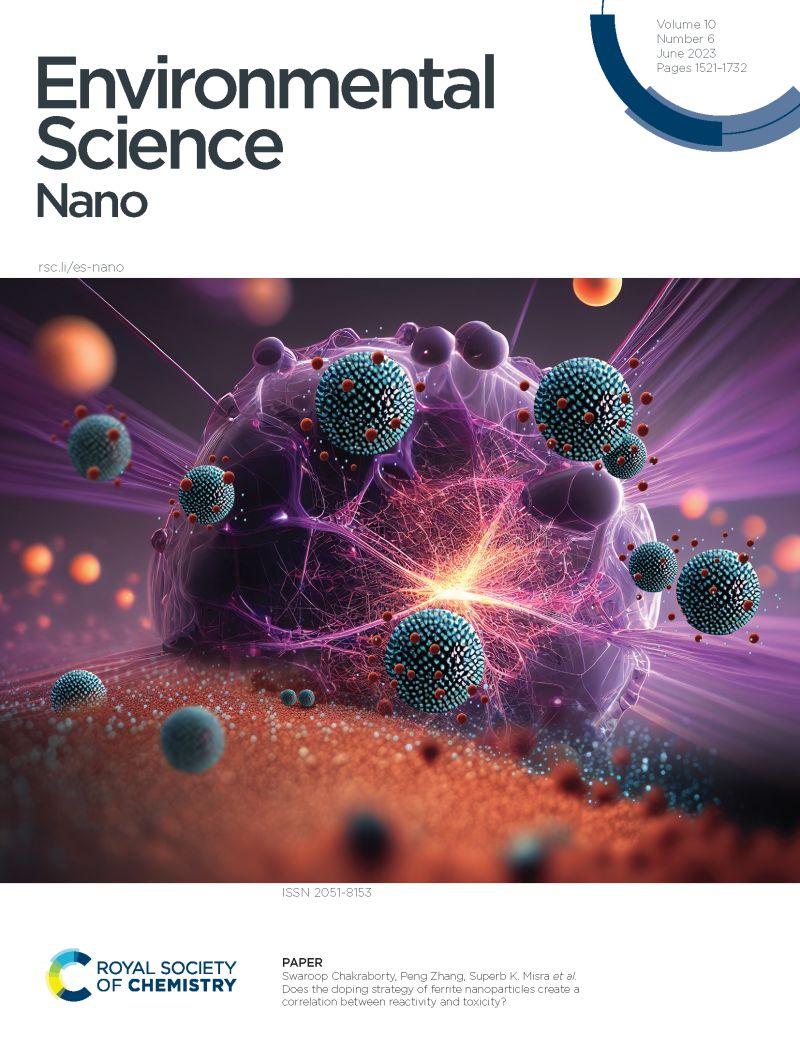开发与环境相关的微塑料和纳米塑料,以评估废水处理工艺中的去除效率
IF 5.8
2区 环境科学与生态学
Q1 CHEMISTRY, MULTIDISCIPLINARY
引用次数: 0
摘要
微塑料和纳米塑料(MNP)污染已成为一个日益令人担忧的环境问题。污水处理厂是 MNP 污染的一个重要来源,因为相关处理方法并不能完全去除 MNP。目前,有关从水和废水中去除这些物质的研究备受关注。然而,要准确地进行这些研究,并校准和验证能够确定其在水和废水中浓度的分析技术,就需要合适的参考材料。这项研究为开发此类材料提供了新的思路。我们采用一种简单、直接和经济有效的方法,通过非溶剂沉淀法制备了目标商品聚合物(聚乙烯 (PE)、聚丙烯 (PP)、聚苯乙烯 (PS)、聚氯乙烯 (PVC) 和聚对苯二甲酸乙二醇酯 (PET))的 MNP,粒度范围为 20 至 3500 nm。获得的 MNP 经紫外线/O3 暴露老化,以模拟塑料的自然风化。我们评估了颗粒在各种介质中的分散性,并在不同的水介质中使用老化和未老化颗粒进行了一系列凝结/絮凝试验。这些测试结果表明,"生态电晕 "已经形成,它对 MNP 的胶体行为有很大影响。这项工作中获得的 MNP 被证明适用于评估混凝/絮凝过程中的 MNP 去除效率,前提是使用与废水化学成分相似的适当介质。这项研究不仅有助于开发具有代表性的参考材料,还为了解废水中 MNP 的胶体行为提供了新的视角,有助于优化废水处理过程中的去除效率。本文章由计算机程序翻译,如有差异,请以英文原文为准。
Developing environmentally relevant micro- and nanoplastics to assess removal efficiencies in wastewater treatment processes
Micro and nanoplastics (MNP) pollution has become an increasingly concerning environmental issue. Wastewater treatment plants represent a significant source of MNP pollution, as the treatments involved do not completely remove them. Studies on their removal from water and wastewater are of current interest. However, suitable reference materials are necessary to conduct these studies accurately and to calibrate and validate analytical techniques capable of determining their concentration in water and wastewater. This work provides new insights into developing such materials. By a simple, straightforward, and cost-effective method, we produced MNP of target commodity polymers: polyethylene (PE), polypropylene (PP), polystyrene (PS) , polyvinyl chloride (PVC) and polyethylene terephthalate (PET) in sizes ranging from 20 to 3500 nm through non-solvent precipitation. The MNP obtained were aged by exposure to UV/O3 to simulate natural plastic weathering. We assessed the dispersibility of the particles in various media and conducted a series of coagulation/flocculation tests using both aged and non-aged particles in different aqueous media. The results of these tests suggest that an 'eco-corona' was formed, which strongly influences the colloidal behavior of MNP. The MNP obtained in this work proved to be suitable for assessing MNP removal efficiency in coagulation/flocculation processes, provided that an adequate medium with a chemical composition resembling that of wastewater is used. This research not only contributes to the development of representative reference materials but also provides new insights into the colloidal behavior of MNP in wastewater, which could help optimize removal efficiencies in wastewater treatment processes.
求助全文
通过发布文献求助,成功后即可免费获取论文全文。
去求助
来源期刊

Environmental Science: Nano
CHEMISTRY, MULTIDISCIPLINARY-ENVIRONMENTAL SCIENCES
CiteScore
12.20
自引率
5.50%
发文量
290
审稿时长
2.1 months
期刊介绍:
Environmental Science: Nano serves as a comprehensive and high-impact peer-reviewed source of information on the design and demonstration of engineered nanomaterials for environment-based applications. It also covers the interactions between engineered, natural, and incidental nanomaterials with biological and environmental systems. This scope includes, but is not limited to, the following topic areas:
Novel nanomaterial-based applications for water, air, soil, food, and energy sustainability
Nanomaterial interactions with biological systems and nanotoxicology
Environmental fate, reactivity, and transformations of nanoscale materials
Nanoscale processes in the environment
Sustainable nanotechnology including rational nanomaterial design, life cycle assessment, risk/benefit analysis
 求助内容:
求助内容: 应助结果提醒方式:
应助结果提醒方式:


